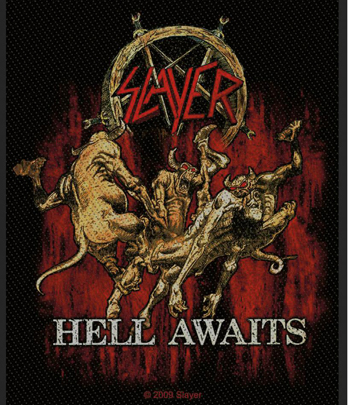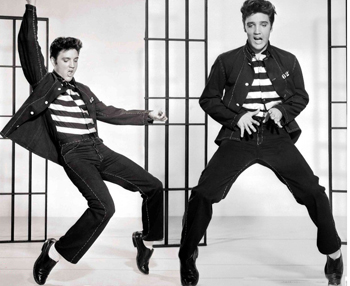Ambiences and Tendencies
 |
 |
 |
 |
 |
 |
 |
Rock ‘n Roll: Satanic Music - I
The Origin of Rock ‘n Roll, Its Promoters
Introduction
For more than a half century, a powerful revolution has been taking shape. A revolution with no political party, no election speeches and even without an ideological platform to state the aims and objectives of the new revolutionaries.

Heavy metal band Slayer with openly Satanic symbols and lyrics; below, its message on an album cover

The socio-cultural phenomenon of rock that appeared in the early ‘50s, however, would spread throughout the world like a undercurrent mixed with mud, slag, blood and human sacrifice. Today, rock music has developed to become the most powerful destroyer of bodies, spirits and hearts that ever emerged from the bowels of Hell.
As early as 1950, however, the world received a serious warning during an exorcism performed in Western Canada by a priest of Long Beach in California. Before leaving the possessed young woman, the evil spirit revealed who he was: “I’m a prince and I have arrived. I came to possess a whole race, the youth of America.” (2)
Another important detail imposes itself. The study of 18 cases of sudden suicides in less than a year among youths age 15 to 21 in the Montreal-Granby-Québec region showed only one constant factor: all were fans of rock ‘n roll.
Is anything more needed to propel me into an in-depth exploration of these human tragedies caused by the devilish and satanic rhythms of this infernal music?
The purpose of this series of articles is to offer the most accurate information possible about the global phenomenon of rock and to make readers acutely aware of its danger and take a strong and energetic position against this global revolution that is affecting youth everywhere.
Let me remind my reader not to lose hope because Christ is victorious. (3)
Phase one: Its birth
In 1951-1952, a young American singer from the Midwest named Little Richard began to change the beat (4) of the “rhythm and blues” of blacks in the South. In 1955, the famous social commentary film Blackboard Jungle marked the rock ‘n roll revolution by featuring Bill Haley’s Rock Around the Clock in its soundtrack.

Provocative & obscene movements of Elvis Presley
In 1954-1955, a young singer and guitarist mastered the technique and musical form of this new music genre. This youth from Memphis, Tennessee was Elvis Presley. (6) This unknown artist stood out because of his personal adolescent revolution against the puritanical morals of the “Bible belt.” (7) He practically incarnated the desire of youth to reject the religious and sexual taboos (8) of society.
Elvis wanted to arouse the youth not only by his music and his words, but also by the obscene and provocative gestures that accompanied his shows. From the beginning, he was called “Elvis the Pelvis” because of the excessive rotations of his pelvis.
Notwithstanding, celebrity and official recognition were accorded him after his appearance on the Ed Sullivan Show in 1956. The reaction of the public was immediate and irreversible. Even though the cameraman took the precaution of capturing only the face and torso of the singer, he could not prevent the transmission of the revolutionary message of Elvis Presley.

Townshend led the way into heavy metal
Finally, the amplifiers permit the desired effect when the percussion instruments in full power explode on the senses of the defenseless listener: drums, cymbals, trumpets, strident screams, electronic synthesizers, everything is orchestrated for a final assault on the delirious crowd.
The intent is to wrap and immerse the audience in a raging ocean sound. This is just the start of hard rock, which drowns the audience in a ritual of sex, perversion and rebellion. Of all the artists of “heavy rock,” it is undoubtedly Peter Townshend (9) who consecrated the genre. If Alice Cooper can be called “hard rock” genius, Peter Townshend is its consummate maestro.
In the next article I will look at this second phase: The evolution of rock ‘n’ roll to “hard” and “acid” rock.
Continued
- This alludes to the famous 18th century legend of the Pied Piper of Hamelin, a German city. After the Piper rid the city of all of its rats by playing his magical flute, the town refused to pay him as they had agreed. He retaliated by playing his flute and enchanting all the children of the city, who followed him into an opening in the mountain which then closed. The children never returned.
- “I’m a Prince and I’m coming down. I'm coming down to possess a race, the youth of America.” Gary Greeneald, Satan, the God of Rock, (cd or mp3)
- In the world you shall have tribulation, but have confidence: I have overcome the world (Jn 16.33).
- Beat: the incessant repetition of regular pulses combined with syncopated rhythms, usually secured by the drums and faithfully reproduced by bass guitars. It is the off-beat that is the defining characteristic of rock ‘n roll.
a) Hard rock: here the beat is designed to excite sexual instincts. Peter Townshend is the creator of heavy metal beat, with its emphasis on percussion and the electronic bass guitar;
b) Acid rock: the beat in this style is conceived to stimulate the nervous system and brain toward hallucinogenic drugs such as LSD, morphine, cocaine and heroin.
c) Punk rock: the beat in this style is devised to excite the instincts to violence and a kind of frenzy with the aim of stimulating participants to an automated state or physical aggression. - See W. Joseph Matt, Rock n’ Roll, A Revolutionary Form of Cultural Subversion, The Remnant Press, 1972, p. 16. Cf. appended bibliography
- The reader will find in Appendix A a brief bibliographic note on several rock musicians referred to in this study.
- A region of the Southern and Midwestern US dominated by a strict fundamentalist Protestantism that dictates a literal and rigid interpretation of the Bible.
- Taboo: the system, practice, or action whereby things are set apart as sacred, forbidden for general use, or placed under a prohibition or interdiction to protect religious or social interests: e.g. incest, public obscenity, blasphemy, desecration of holy things, respect for the dead, places of worship and consecrated objects. The rock revolution is dangerous because it tends to eliminate all religious, family and social taboos from the conscious and the subconscious.
- See Appendix A.
and rock music, was a Trinitarian priest in Northbay, Ontario, Canada.

Posted September 14, 2015
______________________
______________________








